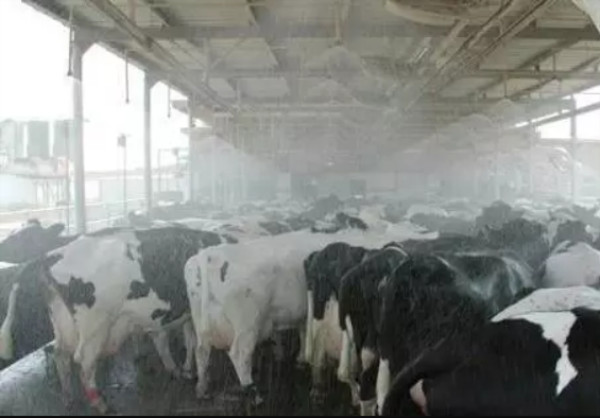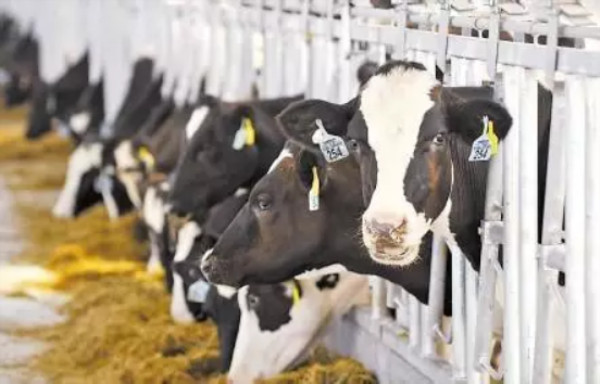March 19th, 2019
By Xiao Xiangqian, Angel Animal Nutrition, China
Dairy cow heat stress refers to a state in which the cow can not release excess heat from the body when it is stimulated by excessive high temperature which exceeds its ability to regulate body temperature, so that it can not maintain normal body temperature. Holstein dairy cows are characterized by large size, poor heat dissipation area per unit body weight, better cold resistance of body hair and tissues, poor sweat excretion ability and poor heat dissipation ability of body surface, which lead to their cold and heat resistance and extremely sensitive to high temperature in summer. The ideal ambient temperature of dairy cows is - 0.5 - 21 ℃, and the optimum ambient temperature of lactating cows is 5 - 25℃. When heat stress is stimulated, dairy cows show a series of physiological reactions, i.e. heat stress syndrome, mainly including heat asthma, heart rate acceleration, membrane system damage, thyroid and adrenal function enhancement, slow oxidation metabolism in vivo, increase of peroxides, slow metabolism of substances, decrease of immunity, disturbance of water and electrolyte balance, increase of urination, increase of ion loss and so on. The decrease of feed intake, milk production, milk quality, reproductive performance and a series of diseases induced by adult cows have reduced the economic benefits of farming.
Judgment of heat stress in dairy cows
Heat stress in dairy cows is caused by many external and internal factors. Therefore, the evaluation of heat stress in dairy cows is mainly based on external environmental factors (THI), combined with physiological (respiratory rate, rectal temperature, heart rate, pulse), biochemical indicators (heat stress protein, cortisol, thyroxine, etc.). In actual production, THI is used as an important index to determine whether cows are under heat stress in summer, especially as an important index to evaluate the effects of heat stress on production performance, physiological and biochemical indicators of dairy cows. For dairy cows, THI > 68 means heat stress.When THI reached 68, cows breathed more than 60 times per minute, rectal temperature exceeded 38. 5 C, and began to lose milk.When THI reached 70, the respiratory rate exceeded 70 breaths per minute and the rectal temperature exceeded 39 C, which was characterized by mild heat stress.When THI reached 80, the respiratory rate exceeded 85 breaths per minute, rectal temperature exceeded 40 C, showing moderate heat stress.When THI reached 90, the respiratory rate was 120-140 breaths per minute, rectal temperature exceeded 41 C, which was characterized by severe heat stress.
Technical measures of dairy cow heat stress regulation
Physical environmental regulation technology
1. Reducing solar radiation
To alleviate the stress effect of high temperature climate on dairy cows, the first is to reduce direct and indirect sunshine. The roof and sunface of cowshed should be made of materials with good thermal insulation and strong reflection, and light-colored and bright corrugated metal sheets can be selected. The construction of awning is a simple and economical way to minimize the radiation of solar box. The distance between the top of the canopy and the cow should be at least 3. 66m.

2. Cooling system
Spray can play the role of air cooling, and spray can cool down the body. Spray can be used in areas with low humidity, but spray is not suitable in areas with high humidity. Because fog droplets are not easy to penetrate through cattle's hair, they can not reach the skin, but increase the air humidity and increase the temperature and humidity index. The combination of fan and high pressure spraying has a significant cooling effect on dairy cows. The combination of fan and spraying was used to cool the cows for 20 minutes and 10 minutes intermittently, which produced 2 kg more milk per day than the shaded control cows, and the rectal temperature was almost normal. Dairy cows need to be cooled in the waiting area, the return passage and the feeding trough.


Technical Measures of Feeding Management
1. It is advisable to control the feeding density of the herd. The area occupied by each adult cow in the cowshed is about 5 m2, and the area occupied by each adult cow in the sports ground is 15-20 m2.
2. Increase feeding times, prolong feeding time, avoid noon, try to arrange more feeding in the morning and evening, less feeding at noon.
3. According to the local climate change characteristics, avoid milking during the peak temperature period.
4. Adjust calving date, try not to breed in September-November, avoid calving in June-August.
5. Strengthen environmental hygiene management, replace water storage tank and remove surplus forage every day, clean up feces in time, disinfect regularly, and avoid aggravating heat stress caused by diseases.

Technical Measures of Nutrition Regulation
1. Provide adequate and clean drinking water.
In high temperature season, water evaporation can dissipate excess body heat. When heat stress occurs, the water consumption of dairy cows can be increased by 20% - 50%. Therefore, sufficient sinks, suitable water pressure and clean and fresh drinking water should be ensured.
2. Increase the ratio of fineness to roughness.
The proportion of concentrate can be increased appropriately under heat stress, but it should not exceed 60%. Provide high quality, palatable green juicy feed, such as alfalfa, ryegrass, etc. During the period of heat stress, dietary CF content was about 17%, NDF content was 25%-28%, ADF content was 18%-19%. Excessive fiber content reduces feed intake and low fiber content affects rumen fermentation of dairy cows and reduces feed utilization rate. TMR feeding technology can be used in production to achieve a balanced supply of concentrate and roughage.
3. Increase the energy level in the diet.
Energy is the first limiting nutrient in the diet of high-yield dairy cows. During heat stress, dry matter intake of dairy cows decreases, energy intake decreases, and energy maintenance needs to increase. Generally, adding fatty acids to improve energy is the most effective. The diet can be supplemented with 200-400 g fatty acid calcium, cottonseed and rapeseed to improve energy level.
4. Increase the protein level in the diet.
Heat stress reduces dry matter intake and protein intake. Increasing dietary protein concentration is conducive to maintaining milk performance of dairy cows. Cottonseed cake, peanut cake and beer grains can be added to the diet to increase the crude protein concentration. However, the protein concentration should not be too high, otherwise it will cause the waste of nitrogen and increase the heat load of dairy cows. The protein level in the diet dry matter is 17%-20%. Increasing the proportion of rumen-passing protein in protein is an effective measure to alleviate heat stress. The proportion of rumen-passing protein in crude protein is 35%-38%.
5. Increase the level of minerals in the diet.
Sodium and potassium can maintain water balance, ion balance and acid-base balance, so it is very important for heat stress dairy cows. The contents of potassium, sodium, magnesium and sodium bicarbonate in dry matter were 1. 0%-1. 5%, 0.4%-0.5%, 0.3%-0.5% and 1%-1. 5% respectively. At the same time, chromium supplementation (suitable dosage: 8mg/head day) was also helpful to improve the stress resistance of dairy cows.
6. Increase the level of vitamins in the diet.
Because of the decrease of intake during heat stress, the vitamin concentration should be increased accordingly. Especially the content of VA and VE can be 3-5 times of the constant, and the content of VC can be increased to 0.04%-0.06% of the dairy cow diet.
7. Use anti-stress products.
Yeast, rumen hormone, complex enzyme preparation, benzodiazepines and Chinese herbal medicine are commonly used additives to alleviate heat stress in dairy cows. Yeast can regulate rumen microbial flora, improve rumen fermentation, improve feed digestibility and alleviate heat stress. For example, Yeavita R produced by Angel Yeast can reduce rectal temperature and respiratory frequency of heat-stressed cows, increase feeding intake, stabilize milk production, and has a strong anti-heat stress effect.
Hot summer is a high incidence period of heat stress in dairy cows. To cope with heat stress in dairy cows, comprehensive regulation and control should be carried out by various technical means in order to avoid economic losses.

About Angel Animal Nutrition:
Fubon is a brand of Angel Animal Nutrition. Fubon is committed to developing natural, efficient microbial feed derived from yeast with Angel's leading technology in yeast industry, providing the best service solutions for the nutrition and health in animals. Angel Animal Nutrition creates value for global feed and animal agriculture customers through continuously upgraded products and professional services.
About Angel:
Angel Yeast Company is a high-tech listed company specializing in yeast and biotech. Product business covers Yeast and Baking, Yeast Extract-Savoury, Nutrition & Health and Biotechnology fields. It is one of the world's leading companies in the yeast industry. Angel has 12 holding subsidiaries and provides products and services for more than 150 countries and regions.
Press contact:
ANGEL YEAST CO.,LTD
Address: 168 Chengdong Avenue, Yichang, Hubei 443003, P. R.China
Tel: +86-717-6369520, 6369558
Fax: +86-717-6370680
email: aie@angelyeast.com







